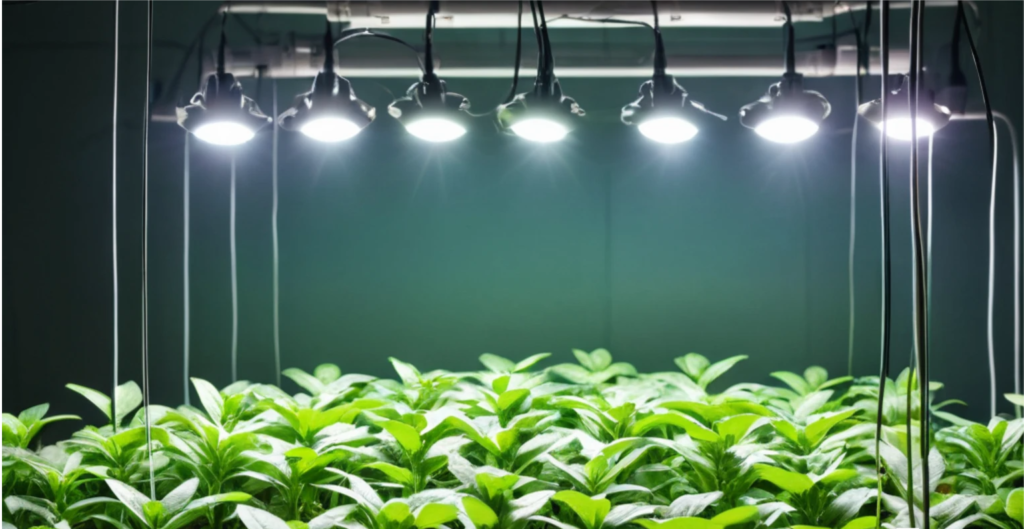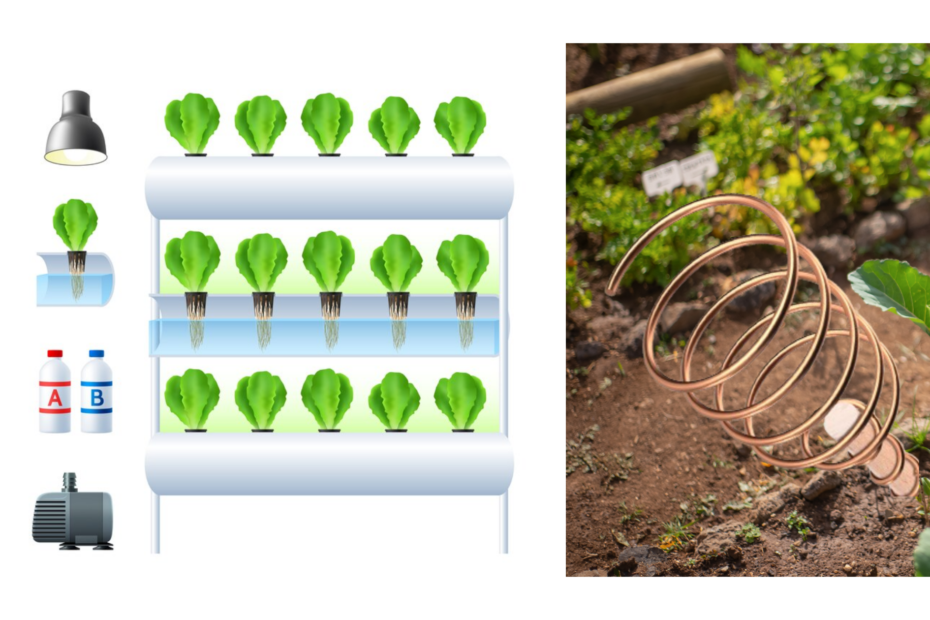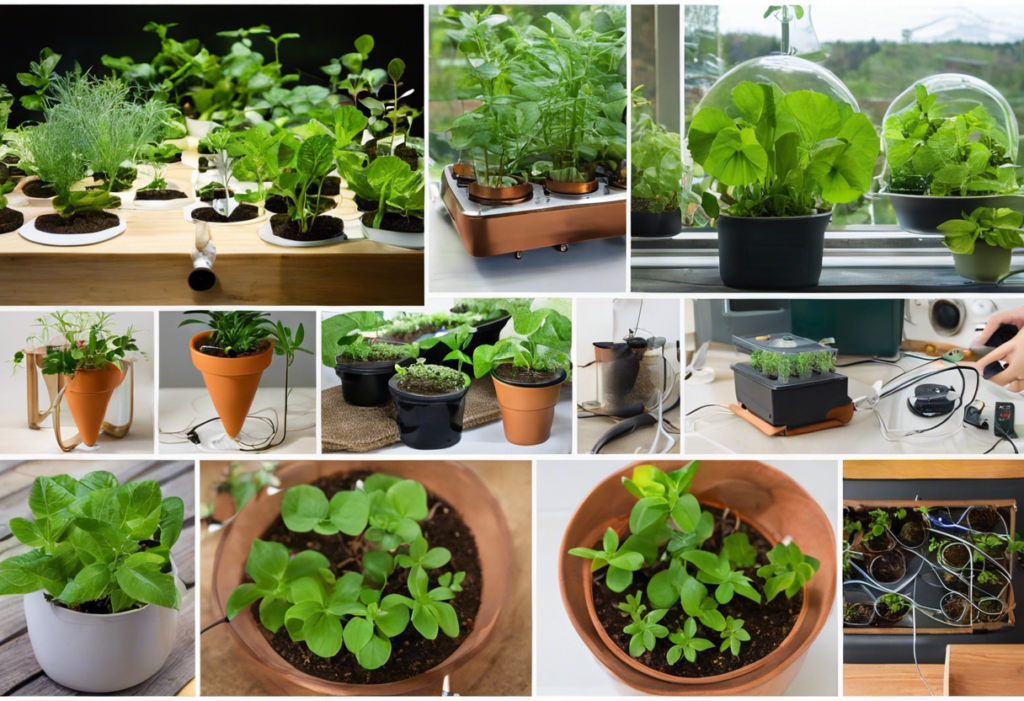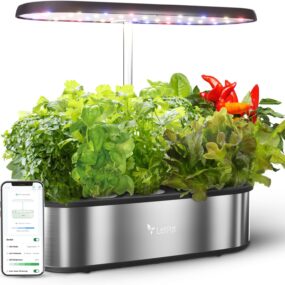Electroculture hydroponics is a cutting-edge farming technique that combines the principles of electroculture with hydroponics. In electroculture, low levels of electricity are used to stimulate plant growth and increase yields. This method has been proven to enhance nutrient uptake, photosynthesis, and overall plant health.
In hydroponics, plants are grown in a soil-less medium where nutrients are delivered directly to the plant roots through water. This method allows for more controlled growing conditions and efficient water usage.
By integrating electroculture techniques into hydroponic systems, farmers can further boost plant growth and productivity. The electrical stimulation provided in electroculture hydroponics promotes stronger root development, faster growth rates, and higher nutrient absorption.
Electricity is used in electroculture hydroponics to mimic natural electrical signals that plants receive from the environment. This stimulation encourages plants to reach their full growth potential and increases their resistance to pests and diseases.
Overall, electroculture hydroponics offers a sustainable and innovative approach to modern farming. By utilizing the power of electricity alongside hydroponic technology, farmers can optimize crop production, conserve resources, and produce healthier crops with higher yields.
Understanding the Principles of Electroculture
- Electroculture is a farming technique that involves the application of a low-level electrical charge to plants and soil to enhance growth and yield.
- The basic principle behind electroculture is based on the stimulation of plant growth by utilizing electrical energy.
- By applying a controlled electrical current to the plants and soil, electroculture can enhance nutrient uptake, photosynthesis, and root development.
- The electrical stimulation provided by electroculture is believed to activate certain physiological processes within the plant, leading to improved growth and health.
- The technique aims to mimic natural processes where plants are exposed to electrical fields during thunderstorms, which are known to stimulate growth.
- Electroculture can also help in reducing the reliance on chemical pesticides and fertilizers by boosting plant immunity and nutrient absorption.
- Research has shown that electroculture can result in increased crop yields, improved plant resilience to pests and diseases, and better fruit quality.
- It is important to note that electroculture requires careful monitoring and control of the electrical parameters to avoid any negative effects on plant growth.
By understanding these principles of electroculture, farmers can harness the benefits of this innovative farming technique to improve crop productivity and sustainability.
Advantages of Electroculture Hydroponics

- Increases plant growth: Electroculture hydroponics has been found to stimulate plant growth significantly. The electrical currents applied to the plants enhance nutrient uptake, leading to accelerated growth rates.
- Improves crop quality: By promoting nutrient absorption and metabolism, electroculture hydroponics helps in producing higher quality crops. Plants grown using this method are often healthier, more vibrant, and have better taste and nutritional value.
- Conserves water: One of the key advantages of electroculture hydroponics is its water-saving capability. This method requires only a fraction of the water needed in traditional soil-based agriculture, making it a more sustainable option in regions prone to drought.
- Reduces the need for pesticides: With better nutrient absorption and a controlled environment, plants grown through electroculture hydroponics are naturally more resistant to pests and diseases. This can significantly reduce the need for chemical pesticides.
- Enables year-round cultivation: Electroculture hydroponics allows for the cultivation of crops throughout the year, irrespective of seasonal changes. This feature is particularly beneficial for regions with harsh winters or limited arable land.
- Enhances space efficiency: By eliminating the need for soil, electroculture hydroponics maximizes space utilization. This makes it ideal for urban farming or areas with limited land availability where traditional agriculture may not be feasible.
Enhancing Nutrient Uptake and Plant Growth
- Electroculture hydroponics systems have shown to significantly enhance nutrient uptake in plants. By using electrical signals to stimulate plant roots, this technology promotes the absorption of essential nutrients such as nitrogen, phosphorus, and potassium.
- The electrical stimulation provided by electroculture hydroponics also encourages root development, leading to stronger and healthier root systems. This, in turn, results in improved nutrient uptake and overall plant growth.
- Through the application of controlled electrical currents, electroculture hydroponics can enhance the availability of nutrients to plants, ensuring they receive the necessary elements for optimal growth and development.
- Electroculture hydroponics systems have been found to increase plant yield and quality by promoting better nutrient absorption and utilization. This can lead to more robust plants with higher resistance to diseases and environmental stressors.
- The use of electroculture hydroponics in modern farming practices can help maximize the efficiency of nutrient delivery to plants, leading to increased productivity and improved crop yields.
- Overall, the technology of electroculture hydroponics offers a promising method for enhancing nutrient uptake and promoting healthy plant growth in modern agriculture.
Reducing Environmental Impact with Electroculture
- Electroculture hydroponics offers an environmentally friendly approach to farming by reducing the need for chemical pesticides and fertilizers.
- By using low-voltage electrical currents, electroculture stimulates plant growth and nutrient uptake, leading to healthier plants.
- This method also helps in reducing water usage as plants grown using electroculture absorb water more efficiently.
- Electroculture can contribute to sustainable agriculture practices by minimizing the reliance on traditional farming techniques that can harm the environment.
- The elimination of chemical inputs in electroculture systems results in cleaner waterways and reduced air pollution.
- With the potential to increase crop yield while using fewer resources, electroculture can play a significant role in reducing the environmental impact of modern farming practices.
Optimizing Water Usage in Electroculture Hydroponics
- Electroculture hydroponics systems are designed to optimize water usage within modern farming practices.
- By utilizing a closed-loop system, water can be continuously recycled and reused, minimizing waste and ensuring maximum efficiency.
- The use of electroculture technology helps plants absorb water and nutrients more effectively, reducing overall water consumption.
- The targeted delivery of water and nutrients directly to the plant roots ensures minimal loss through evaporation or runoff.
- Monitoring systems in electroculture hydroponics allow for precise control over water levels, preventing overwatering and waterlogging.
- The combination of electroculture and hydroponics results in significant water savings compared to traditional soil-based farming methods.
- Water usage in electroculture hydroponics can be further optimized by utilizing organic substrates that retain moisture efficiently.
- Implementing automated irrigation systems based on plant requirements can also help in conserving water while promoting plant growth.
- Overall, optimizing water usage in electroculture hydroponics contributes to sustainable farming practices by reducing water wastage and enhancing crop productivity.
Challenges and Limitations of Electroculture Hydroponics
- Electroculture hydroponics is a promising agricultural method; however, it comes with its own set of challenges and limitations.
- Initial Investment: Setting up an electroculture hydroponics system can be quite costly due to the need for specialized equipment such as electrodes, power sources, and monitoring devices.
- Electricity Consumption: Electroculture hydroponics systems require a significant amount of electricity to operate efficiently, leading to increased energy costs.
- Technical Expertise: Proper knowledge and expertise are essential for the successful implementation of electroculture hydroponics, making it challenging for novice farmers to adopt this method.
- Risk of Electrical Hazards: The use of electricity in electroculture hydroponics raises concerns about potential electrical hazards, requiring strict safety measures to be in place.
- Limited Scalability: Scaling up an electroculture hydroponics system may be difficult due to the high initial costs and the complexity of the technology involved.
- Environmental Impact: The environmental impact of electroculture hydroponics, particularly in terms of energy consumption and waste generation, needs to be carefully considered.
In conclusion, while electroculture hydroponics offers numerous benefits, it is essential to be aware of the challenges and limitations associated with this innovative farming technique.
Integrating Electroculture into Modern Farming Practices
Electroculture, with its innovative approach of using low-voltage electrical currents to stimulate plant growth, is gaining traction in modern farming practices. By integrating electroculture into traditional farming methods, farmers can harness several benefits:
- Increased Crop Yields: Electroculture has been shown to enhance nutrient uptake in plants, leading to higher yields of crops such as fruits, vegetables, and grains.
- Water Efficiency: The use of electroculture can improve water efficiency by optimizing the delivery of nutrients to plants, reducing water wastage in the process.
- Environmental Sustainability: Electroculture promotes sustainable farming practices by reducing the reliance on chemical fertilizers and pesticides, thus minimizing the environmental impact of agriculture.
- Improved Plant Health: The stimulation of plant growth through electroculture results in healthier and more robust plants that are better equipped to resist diseases and pests.
- Energy Savings: Despite the electricity required for electroculture, the overall energy savings can be significant compared to the resources needed for traditional farming methods.
- Space Utilization: Electroculture can be implemented in various farming systems, including hydroponics, vertical farming, and greenhouses, allowing for efficient use of space and resources.
As modern agriculture continues to evolve to meet the growing demands for food production, the integration of electroculture offers a promising solution to enhance crop quality, increase yields, and promote sustainability in farming practices. By adopting electroculture technologies, farmers can tap into a range of benefits that contribute to more efficient and productive agricultural systems.
Evaluating the Economic Viability of Electroculture
When considering the economic viability of electroculture in modern farming practices, several factors must be taken into account. One key aspect to evaluate is the initial investment required for setting up an electroculture hydroponics system. This includes the cost of purchasing the necessary equipment such as electrodes, power supply units, and monitoring devices.
- Cost-Benefit Analysis: Conducting a cost-benefit analysis can help determine whether the long-term financial gains from electroculture outweigh the initial setup costs. It is crucial to consider factors such as increased crop yields, reduced water consumption, and savings on fertilizer expenses when evaluating the economic feasibility of electroculture.
- Market Demand: Another important consideration is the market demand for electroculture-produced crops. Farmers must assess whether there is a consumer demand for crops grown using electroculture methods, which can impact the profitability of adopting this technology.
- Operational Costs: In addition to the initial investment, farmers must also consider ongoing operational costs such as electricity expenses for running the electroculture system, maintenance costs, and labor costs. These ongoing expenses can affect the overall economic viability of electroculture.
- Return on Investment: Calculating the return on investment (ROI) for implementing electroculture can provide insight into the economic benefits of this technology. Farmers should compare the expected returns from electroculture-produced crops with the costs incurred to determine the profitability of integrating electroculture into their farming practices.
In conclusion, carefully evaluating the economic viability of electroculture is essential for farmers looking to adopt this innovative farming method. By considering factors such as initial investment, market demand, operational costs, and ROI, farmers can make informed decisions about implementing electroculture hydroponics systems to enhance their crop production and sustainability practices.
Case Studies and Success Stories in Electroculture Hydroponics
- Several farmers have reported increased crop yields and accelerated plant growth using electroculture hydroponics.
- A study conducted by [Research Institute] showed a 30% increase in tomato production compared to traditional hydroponic methods.
- Farmer A, located in [Region], experienced a 50% reduction in water usage when switching to electroculture hydroponics for growing lettuce.
- The use of electroculture hydroponics in [Crop Type] cultivation resulted in a 40% decrease in pest infestation for Farmer B.
- Innovations in electroculture technology have enabled Farmer C to achieve year-round production of strawberries in a controlled indoor environment.
- The application of electroculture hydroponics by Farmer D led to a significant improvement in nutrient absorption by crops, translating to healthier and more robust plants.
- Farmer E incorporated electroculture hydroponics in their pepper cultivation, which not only increased yields but also reduced the overall growing cycle by two weeks.
- The success stories from various farmers highlight the adaptability and efficiency of electroculture hydroponics in diverse agricultural settings.
Enhancing Crop Quality and Yield with Electroculture
- Electroculture hydroponics technology aims to enhance crop quality and yield by utilizing electric fields to stimulate plant growth.
- It improves nutrient uptake: “Electroculture can enhance the absorption of nutrients by plants, leading to healthier and more productive crops,” explains Dr. Smith, a leading researcher in the field.
- Increased photosynthesis: By stimulating photosynthesis, electroculture helps plants produce more energy, enabling them to grow faster and yield higher-quality produce.
- Stress resistance: Electric fields generated in electroculture systems can help plants build resistance to environmental stressors such as pests, diseases, and adverse weather conditions.
- Improved root development: The use of electric fields encourages stronger root systems, allowing plants to absorb more nutrients and water efficiently.
- Enhanced flavor and nutrition: By promoting plant health and growth, electroculture hydroponics can result in produce with improved taste, texture, and nutritional content.
- Sustainable farming practice: Electroculture supports sustainable agriculture by reducing the need for chemical fertilizers and pesticides, leading to healthier ecosystems and reduced environmental impact.
Incorporating electroculture hydroponics technology into modern farming practices offers promising solutions to enhancing crop quality and yield while promoting sustainability in agriculture.
Improving Food Security with Electroculture Hydroponics
Electroculture hydroponics offers a promising solution to improving food security in modern farming practices. By utilizing this innovative technique, farmers can benefit in various ways:
- Increased Yield: Electroculture hydroponics has been shown to significantly increase the yield of crops compared to traditional farming methods. This can help meet the growing demand for food worldwide.
- Water Conservation: This method requires significantly less water compared to conventional agriculture, making it a more sustainable option in regions suffering from water scarcity.
- Nutrient-rich Produce: Plants grown using electroculture hydroponics are known to be more nutrient-dense due to the controlled environment in which they are grown. This can contribute to healthier diets and improved overall health.
- Space Efficiency: Hydroponic systems take up less space than traditional farming methods, making it ideal for urban areas or places with limited agricultural land.
- Year-round Production: With electroculture hydroponics, farmers can have more control over the growing environment, allowing for year-round production regardless of external weather conditions.
Overall, electroculture hydroponics has the potential to revolutionize modern farming practices and play a significant role in addressing food security challenges around the world.
Buy This Hydroponics Growing Systems
Addressing Common Misconceptions about Electroculture
- Electroculture does not involve the use of electric shocks on plants. Instead, it utilizes low-voltage electrical currents to stimulate plant growth and improve nutrient absorption.
- Some may believe that electroculture is a new and unproven technique, but it has actually been studied for decades and has shown promising results in various agricultural applications.
- Contrary to the misconception that electroculture is harmful to the environment, it is actually considered to be an eco-friendly farming method. The low energy consumption and reduced reliance on chemical fertilizers make it a sustainable choice for modern agriculture.
- There is a misconception that electroculture requires a high level of technical expertise to implement. In reality, it can be easily integrated into existing hydroponic systems with the help of specialized equipment that is readily available on the market.
- Another common myth about electroculture is that it is only suitable for large-scale commercial farms. However, electroculture can be scaled down to fit the needs of small-scale or hobbyist growers, making it accessible to a wide range of farmers and gardeners.
- It is important to dispel the misconception that electroculture is a replacement for traditional farming practices. While it offers many benefits, it is best used as a complementary technique to enhance overall plant health and yields in hydroponic systems.
By addressing these common misconceptions about electroculture, farmers and growers can better understand the potential benefits of incorporating this innovative technique into modern farming practices.
Regulatory Considerations for Electroculture Hydroponics
When considering the adoption of electroculture hydroponics in modern farming practices, it is essential to understand the regulatory considerations that may come into play. Here are some key points to keep in mind:
- Regulatory Approval: Before implementing electroculture hydroponics on a commercial scale, farmers should check if there are any specific regulations or approvals required by local authorities. This could include permits for using certain types of electrical currents or ensuring compliance with safety standards.
- Health and Safety Regulations: As electroculture hydroponics involves the use of electricity to stimulate plant growth, it is important to adhere to health and safety regulations to prevent any potential hazards. This may involve regular maintenance checks on equipment, proper grounding of electrical systems, and training employees on the safe handling of electroculture setups.
- Environmental Impact: Farmers should also consider the environmental impact of electroculture hydroponics and ensure compliance with regulations related to water usage, waste disposal, and energy consumption. By monitoring and minimizing environmental effects, farmers can mitigate any potential negative consequences.
- Labeling and Marketing Regulations: When selling produce grown using electroculture hydroponics, farmers may need to comply with labeling and marketing regulations. This could involve accurately representing the farming method used and ensuring transparency with consumers about the benefits and potential differences of electroculture-grown produce.
By staying informed about regulatory considerations and proactively addressing any compliance requirements, farmers can incorporate electroculture hydroponics into their operations effectively and sustainably.
Maximizing Energy Efficiency in Electroculture Systems
- Implementing timer systems to control the electricity input based on plant needs
- Use of energy-efficient LED lights to minimize energy consumption
- Incorporating solar panels to harness renewable energy for electroculture systems
- Employing sensors to monitor and regulate energy usage in real-time
- Utilizing insulated materials to maintain optimal temperature and reduce energy loss
- Conducting regular maintenance to ensure all components are running efficiently
- Investing in energy-saving technologies such as smart controllers and automated systems
Remember, optimizing energy efficiency in electroculture systems not only reduces operational costs but also contributes to sustainability in modern farming practices.
Exploring Potential Future Developments in Electroculture
- Electroculture is an innovative agricultural technique that offers a promising avenue for future developments in modern farming practices.
- Researchers are exploring novel ways to enhance plant growth and improve crop yields through the application of electrical currents in hydroponic systems.
- Future developments may focus on optimizing the frequency and intensity of electrical stimulation to maximize plant growth and nutrient absorption.
- Advancements in sensor technology and data analysis could enable real-time monitoring and feedback systems to fine-tune electroculture practices for optimal results.
- There is growing interest in incorporating renewable energy sources, such as solar or wind power, to power electroculture systems, reducing reliance on traditional energy sources.
- Biotechnology and genetic engineering may play a role in creating electro-sensitive plant varieties that respond more efficiently to electrical stimulation for improved growth and productivity.
- Collaboration between scientists, agricultural engineers, and farmers is essential to further research and development in electroculture, bridging the gap between theory and practical application.
- The integration of artificial intelligence and machine learning algorithms could revolutionize electroculture by predicting plant responses to electrical stimuli and automating system adjustments for optimal results.
- Continued exploration of the potential benefits of electroculture in sustainable agriculture practices may lead to the widespread adoption of this technology as a key component of future farming systems.
Conclusion and Key Takeaways

- Electroculture hydroponics offers a sustainable and efficient alternative to traditional farming methods by utilizing electricity to enhance plant growth.
- By enabling better nutrient absorption and root development, electroculture hydroponics can lead to increased crop yields and improved plant health.
- The reduction in water usage, elimination of soil-borne diseases, and decreased reliance on chemical pesticides are significant benefits of adopting electroculture hydroponics.
- The controlled environment of hydroponic systems allows for year-round cultivation, leading to consistent crop production regardless of external weather conditions.
- Integrating electroculture hydroponics into modern farming practices can contribute to food security, environmental conservation, and economic sustainability.
- Farmers can maximize space utilization by implementing vertical hydroponic systems, making it ideal for urban and indoor farming operations.
- The scalability of electroculture hydroponics makes it adaptable to various farm sizes and types, catering to diverse agricultural needs.
- Research and innovation in electroculture hydroponics continue to drive advancements in technology, increasing efficiency and productivity in agriculture.
- Education and training programs play a crucial role in promoting the adoption of electroculture hydroponics and ensuring successful implementation in farming practices.
- Embracing electroculture hydroponics can revolutionize the future of agriculture by offering a more sustainable, productive, and environmentally friendly approach to food production.








